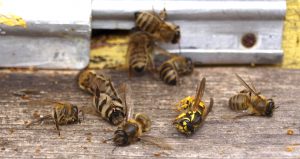02
Feb
Common Pesticide Ingredient Labeled “Inert” Increases Honey Bee Susceptibility to Virus
(Beyond Pesticides, February 2, 2017) A commonly used inert pesticide ingredient negatively affects the health of honey bees by making larvae more susceptible to a virus, according to a recently published study in the journal, Nature. One of the authors of the study, Julia Fine, PhD candidate, stated that the findings, “Mirror the symptoms observed in hives following almond pollination, when bees are exposed to organosilicone adjuvant residues in pollen, and viral pathogen prevalence is known to increase. In recent years, beekeepers have reported missing, dead and dying brood in their hives following almond pollination, and exposure to agrochemicals, like adjuvants, applied during bloom, has been suggested as a cause.”
The study assessed honey bee larval development after exposure to a continuous low dose of Sylgard 309, a surfactant, in their diet. This organosilicone surfactant is commonly used on agricultural crops, including tree fruits, nuts, and grapes. Their results reveal that honey bee exposure to chemical surfactants such as Sylgard 309 led to higher levels of Black Queen Cell Virus and when the bee larvae were exposed to the surfactant and virus simultaneously, “the effect on their mortality was synergistic rather than additive.” This research comes at a time when hundreds of thousands of pounds of these products are being applied annually in California almond orchards alone. Honey bees are trucked in from all around the country to provide this vital pollination service for high value crops, therefore elevating the possibility of damaging additive effects.
Surfactants are added to pesticide formulations to increase their efficacy by reducing surface tension and aiding in overall absorption of the product in the target plant. These inert ingredients often make up the majority, by weight, of the pesticide mixtures that are sold. Despite the uncertainties and potential hazards from inerts, pesticide manufacturers are only required to list the active ingredients in a pesticide under the Federal Insecticide, Fungicide and Rodenticide Act (FIFRA). This leaves consumers and applicators unaware of the possible toxicity present in a vast majority of the pesticide formulations they are using, unless the EPA Administrator determines that the chemical poses a public health threat.
Many inert ingredients are even more toxic than the active ingredients. One of the most hazardous ingredients in the commonly used herbicide Roundup, POEA, is a surfactant that is classified as an inert and therefore not listed on the label. Researchers have found that POEA can kill human cells, particularly embryonic, placental, and umbilical cord cells.
These “inert” ingredients in pesticide formulations are continuing to draw the attention of scientists, and play a part in bee toxicity in conjunction with ongoing investigations into the role of neonicotinoid insecticides in bee health. A 2016 review, titled Toxicological Risks of Agrochemical Spray Adjuvants, links spray adjuvant use with declining honey bee health, based on annual trends in applications of adjuvants and associated pesticide formulations during almond pollination in California. The authors stated, “Among adjuvant classes, the organosilicone surfactants pose the greatest toxicity risks for honey bees.” A separate study released by Pennsylvania State University researchers in 2012 observes that bee learning behavior is impaired by exposure to low doses of surfactants –other ingredients commonly found in pesticide formulations. These researchers measured the olfactory learning ability of honey bees treated orally with sublethal doses of the ,most widely used spray adjuvants on almonds in the Central Valley of California.
In addition to the detrimental effect that inert ingredients have been found to have on honey bees, the body of evidence pointing to the role of neonicotinoids in declining honey bee numbers is consistently growing. Neonicotinoids are a class of insecticides that share a common mode of action that affects the central nervous system of insects, resulting in paralysis and death. While the issue of pollinator declines is diverse and complex, with many factors potentially contributing to the cause, pesticides have consistently been implicated as a key factor, not only through immediate bee deaths, but also through sublethal exposure. Neonics are associated with decreased learning, foraging, and navigational ability, as well as increased vulnerability to pathogens and parasites as a result of suppressed bee immune systems. In addition to toxicity to bees, pesticides like neonicotinoids have been shown to also adversely affect birds, aquatic organisms, and contaminate soil and waterways, and overall biodiversity.
In light of the shortcomings of federal action in the U.S. to protect these beneficial organisms, it is left up to us to ensure that we provide safe havens for pollinators by creating pesticide-free habitat and educating others to do the same. You can pledge your green space as pesticide-free and pollinator-friendly, no matter the size. Sign the pledge today. See our BEE Protective page to find out how you can help this effort and how to get your community, schools, and local government to take action to protect pollinators. Beyond Pesticides also advocates for the adoption of organic land management practices and policies by local communities.
Sources: Nature, Science Daily, Scientific American
All unattributed positions and opinions in this piece are those of Beyond Pesticides.










